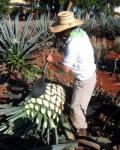Since then, I have become a fan of sauvignon blanc and pinot noir, but I'm still a stranger to the sophisticated world of Scotch drinkers, let alone malt heads.
To correct that shortcoming, I signed up for a whiskey tasting in a most unlikely spot: South Africa, about as far from Scotland as you can get.
I wanted to find out what a single malt is, and the big deal is all about.
At 6 o'clock one evening three of us - a connoisseur of food and spirits from Washington, an affable hospital executive from Colorado and myself - met in Bascule, the smart bar at the Cape Grace Hotel in Cape Town. The 121-room boutique hotel occupies its own quay at the Victoria & Alfred Waterfront, between the working harbor and a marina. Bascule is partially below ground, but its windows look out on a lively dockside deck and the spectacular backdrop of Table Mountain.
"We're going to taste four single malts from four different areas of Scotland, plus an American bourbon and an Irish blend," said Soma. "And along the way I'll tell you a bit about whiskey."
The basics: A single malt is a Scotch whiskey made only from malted barley by a single distillery and aged at least eight years. Blended Scotch whiskies combine up to 50 different single malts, plus grain alcohol.
The widely varying distinctive flavors of both single malts and the blends they make reflect the differences in air, water, soil and peat where the distilleries are, and the kind of casks they were aged in.
The longer whiskey ages, the smoother (and costlier) it gets. Incidentally, the age of the Scotch on the label is the time it spent in the cask, not the bottle. Bascule's rarest, a Glenfiddich 50, for instance, was distilled in 1939 and bottled in 1990 and costs $2,358 a tot (four-fifths of ounce); the Glenfiddich 40 was distilled two years earlier but bottled in 1977, so it aged 10 fewer years - and a tot goes for a mere $275.
I could tell you a lot more whiskey arcana, but let's get to the tasting.
Whiskey 1 was Jack Daniel's, a Tennessee whiskey. "Notice the deep amber color, and the nose. Can you taste maple, licorice, dust?" asked Soma. "And you can tell its age by its legs - the slower they run the older the it is."
Whiskey 2 was the Jameson, an Irish blend, and one of Bascule's most popular whiskies. In Ireland the barley is dried in closed kilns so you don't get the smoky taste of peat fires, explained Soma. He suggested we look for green peach and almond notes, but I couldn't find them, even after adding a little water to make it fuller.
At Whiskey 3 we arrived at the single malts. Glenkinchie is from the Lowlands of central Scotland, which produces the lightest, mildest, least-smoky drink. Yes, I can taste the barley and the oaky dryness, but not the lemon grass.
Glenmorangie was Whiskey 4, from the Highlands, the beautiful hilly region in the north mainland where the varying topography and water supply produces very different whiskies. Highland distillers experiment with aging their whiskies in barrels previously containing other drinks.
Oh, yes.
The similarity between whiskey and wine tasting was growing. They share the same vocabulary - legs, nose, notes - and they are both enhanced by complementary foods. It occurred to me that my Scotch problem might lie with the bar food I was used to: peanuts, chips and olives, salty stuff to pump up your thirst (and your drink orders) that aren't conducive to contemplative whiskey sipping.
Whiskey 5, more golden than amber in color, was a Glen Keith from Speyside, a busy whiskey-distilling region of the Highlands (and home of the vaunted Glenfiddich). Here the barley is malted with very little peat, so the whiskey doesn't have much smoky flavor or aroma. Because Speyside rivers are filled with salmon, Soma had us try it with smoked salmon, which did pick up the sweetness and smoothness for me.
Our last tasting was the palest, a Caol Ila from the island of Islay (say eye-luh) on Scotland's west coast. This is the home of the smokiest, peatiest, most pungent tasting single malts, the Holy Grail of many hardcore malt heads. I wouldn't go as far as a friend of mine who said, "It tastes like dirty socks smell," but it definitely was my least favorite.
Bascule offers three different tastings, each drawn from its collection of over 450 whiskies, the largest in the Southern Hemisphere. Ninety percent of it is Scottish, 5 percent Irish and a smattering are from North America, Australia and South Africa. It opened in 2000, four years after the hotel did, with 220 kinds of whiskey.
It was a short learning curve to get a handle on single malts. My companions happily swirled and sipped through the tasting. I learned that Scotch really isn't my drink. If pushed, I'd take the Glenmorangie - but mainly for the chocolate truffle.
IF YOU GO
Whiskey tastings are available daily, except Tuesday and Sunday, and sample six whiskies. Prices are $22, $28 or $46 per person, depending on the age of the whiskies. Booking is essential, 011-27-21-410-7100, bascule@capegrace.com.
Cape Grace Hotel, West Quay, V & A Waterfront, 011-27-21-410-7100, www.capegrace.com. Double rooms start at $545 until Aug. 31 and $675 Sept. 1-Dec. 19 and include breakfast, value added tax, spa, chauffeured car in the vicinity, free Internet and evening sherry.
Joan Scobey is a freelance travel writer.
© Copley News Service




